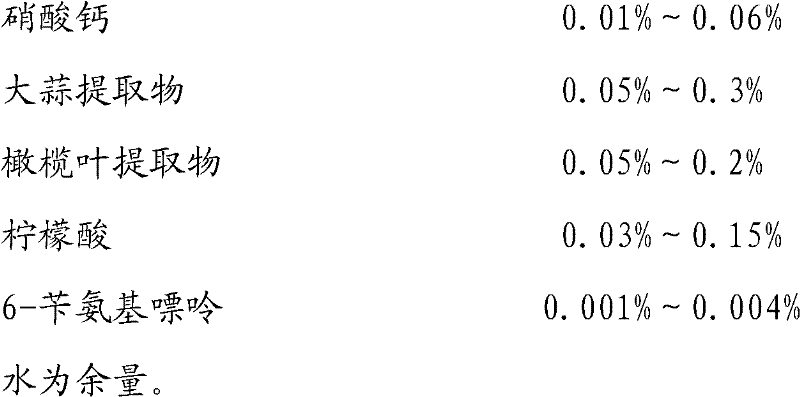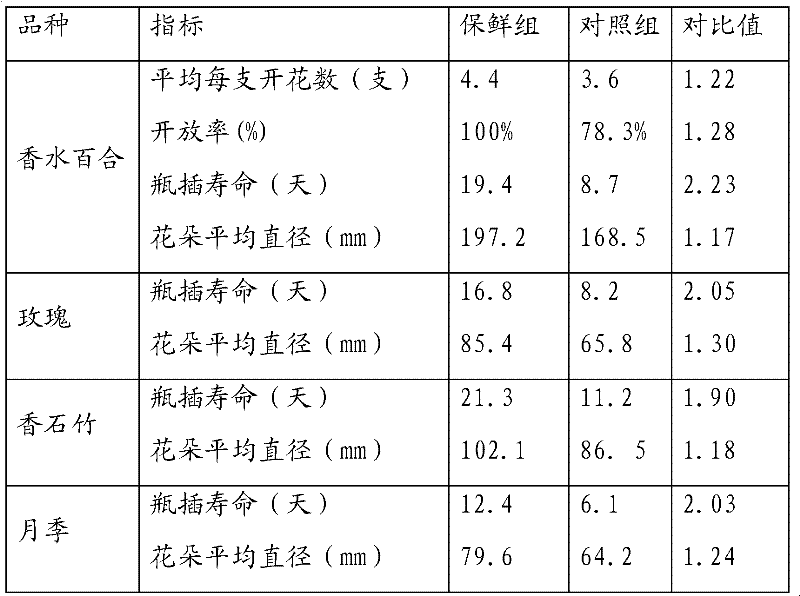Fresh flower preservative
A technology of preservatives and flowers, applied in the preservation of plants, botanical equipment and methods, applications, etc., can solve the problems of ineffective effects, single products, environmental pollution, etc., and achieve good fresh-keeping effects
- Summary
- Abstract
- Description
- Claims
- Application Information
AI Technical Summary
Problems solved by technology
Method used
Image
Examples
Embodiment 1
[0020] A novel flower preservative, which weighs the following components by weight percentage respectively, and mixes each component uniformly to obtain the fresh flower preservative:
[0021] Sucrose 0.5%, 8-hydroxyquinoline sulfate 0.01%, 1-methylcyclopropene 0.001%, gibberellin 0.0005%, calcium nitrate 0.01%, garlic extract 0.05%, olive leaf extract 0.05%, citric acid 0.03 %, 0.001% of 6-benzylaminopurine, and the rest is water.
[0022] Among them, the garlic extract is obtained through the following preparation process: take the garlic, wash it, add 8 times the amount of water of the garlic for beating; adjust the pH value of the slurry to 3.5, control the temperature at 60°C, and add 200,000 international units per kilogram of garlic The specific activity of the enzyme is used for enzymolysis, and the enzymolysis time is 360 minutes. After the end of the enzymolysis, the enzyme is inactivated; That is the garlic extract.
[0023] The olive leaf extract is obtained thr...
Embodiment 2
[0029] A novel flower preservative, which weighs the following components by weight percentage respectively, and mixes each component uniformly to obtain the fresh flower preservative:
[0030] Sucrose 4.0%, 8-hydroxyquinoline sulfate 0.05%, 1-methylcyclopropene 0.004%, gibberellin 0.002%, calcium nitrate 0.06%, garlic extract 0.3%, olive leaf extract 0.2%, citric acid 0.15% %, 0.004% of 6-benzylaminopurine, and the rest is water.
[0031] Among them, the garlic extract is obtained through the following preparation process: take the garlic, wash it, add 4 times the amount of water of the garlic for beating; adjust the pH value of the slurry to 5.5, control the temperature at 40°C, and add 600,000 international Enzyme hydrolysis with the specific activity of the enzyme, the enzymatic hydrolysis time is 180 minutes, after the end of the enzymatic hydrolysis, the enzyme is inactivated; the supernatant is separated, separated and purified by the upper chromatographic column, the f...
Embodiment 3
[0037] A novel flower preservative, which weighs the following components by weight percentage respectively, and mixes each component uniformly to obtain the fresh flower preservative:
[0038] Sucrose 2.25%, 8-hydroxyquinoline sulfate 0.03%, 1-methylcyclopropene 0.0025%, gibberellin 0.00125%, calcium nitrate 0.035%, garlic extract 0.175%, olive leaf extract 0.125%, citric acid 0.09% %, 0.0025% of 6-benzylaminopurine, and the rest is water.
[0039] Among them, the garlic extract is obtained through the following preparation process: take the garlic, wash it, add 6 times the amount of water of the garlic for beating; adjust the pH value of the slurry to 4.5, control the temperature at 50°C, and add 400,000 international The enzyme with specific activity per unit is used for enzymolysis, and the enzymatic hydrolysis time is 240 minutes. After the enzymatic hydrolysis, the enzyme is inactivated; the supernatant is separated, separated and purified by upper chromatography column,...
PUM
| Property | Measurement | Unit |
|---|---|---|
| Molecular weight | aaaaa | aaaaa |
Abstract
Description
Claims
Application Information
 Login to View More
Login to View More - R&D
- Intellectual Property
- Life Sciences
- Materials
- Tech Scout
- Unparalleled Data Quality
- Higher Quality Content
- 60% Fewer Hallucinations
Browse by: Latest US Patents, China's latest patents, Technical Efficacy Thesaurus, Application Domain, Technology Topic, Popular Technical Reports.
© 2025 PatSnap. All rights reserved.Legal|Privacy policy|Modern Slavery Act Transparency Statement|Sitemap|About US| Contact US: help@patsnap.com



